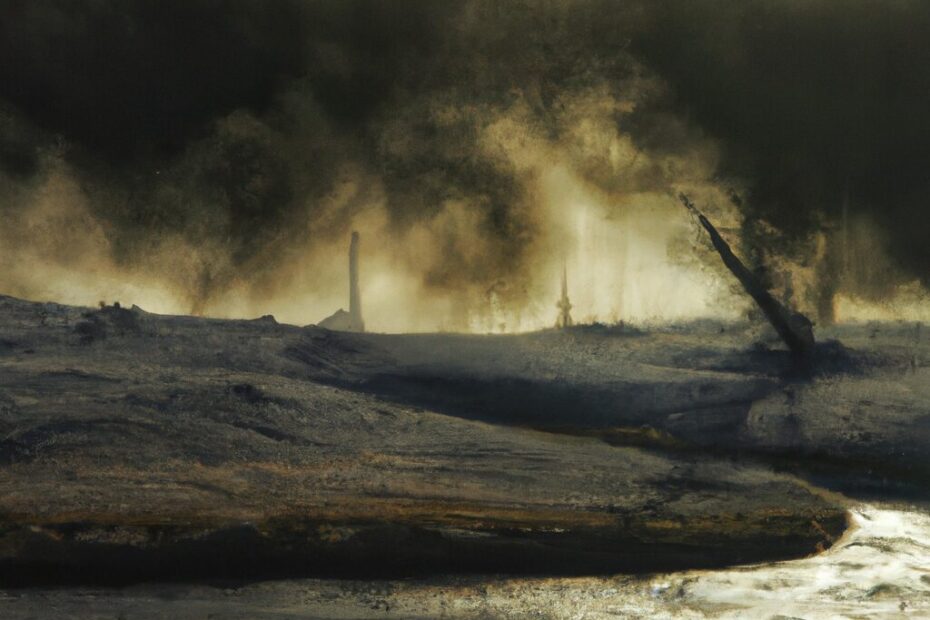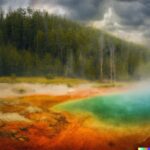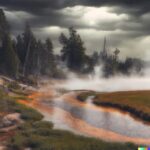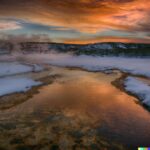Yellowstone National Park is home to some of the most incredible natural wonders, including the famous bubbling geysers that attract visitors from all over the world.
But have you ever wondered how these geysers are formed or what causes them to erupt?
In this article, we will explore the fascinating world of geysers, from their formation to the dangers they pose. We’ll also take a closer look at some of the most famous geysers in Yellowstone, including Old Faithful and Grand Prismatic Spring.
So, buckle up and get ready to dive into the mesmerizing world of geysers!
What Are Geysers?
Geysers are natural hydrothermal features, often associated with volcanic activity, that are found in various locations, including the famous Yellowstone National Park in Wyoming.
These incredible natural wonders result from underground water reservoirs being heated by the Earth’s magma, causing intermittent eruptions of hot water and steam.
The extraordinary display of such volcanic and geothermal activity provides scientists with valuable insights into the Earth’s inner workings. Yellowstone, in particular, boasts a remarkable concentration of geysers, captivating visitors with their awe-inspiring, rhythmic eruptions.
Geysers play a crucial role in shaping the landscapes of geothermal areas, serving as a testament to the powerful forces at work deep beneath the Earth’s surface.
How Are Geysers Formed?
The formation of geysers is a result of complex geological processes involving the interaction of heat, pressure, and specific geological conditions that create the unique phenomenon of erupting hot springs and steam vents.
Geological wonders like geysers are commonly found in areas with volcanic activity. This is because the magma from the Earth’s interior heats up underground water reservoirs, causing intense pressure that leads to the explosive release of steam and hot water. As time passes, mineral deposits accumulate around the vent, giving geysers their unique appearance.
The formation and sustainability of geysers rely on a combination of factors, including heat from the Earth’s interior, availability of water, and the right geological plumbing system. Without these elements, geysers would not be able to exist.
Where Is Yellowstone National Park?
Yellowstone National Park, located primarily in the state of Wyoming, is renowned for its breathtaking geological formations and diverse wildlife habitat, making it a prime destination for nature enthusiasts and researchers alike.
The park’s remarkable geysers, including the famous Old Faithful, as well as its colorful hot springs and dramatic canyons, showcase the dynamic geological forces at work within the park.
Its diverse wildlife habitat sustains populations of iconic species such as bison, elk, and grizzly bears. Yellowstone’s significance as the first national park in the world underscores its role in preserving and protecting these natural wonders and wildlife for future generations to enjoy and study.
What Makes Yellowstone Unique?
Yellowstone stands out as a unique natural wonder due to its exceptional geothermal activity, striking volcanic landscape, and unparalleled natural beauty, attracting visitors and researchers from around the world to witness its extraordinary phenomena.
Location On Top Of A Supervolcano
One of the factors that make Yellowstone unique is its location on top of a supervolcano, which has led to the formation of remarkable geological wonders and the occurrence of significant volcanic eruptions throughout its history.
This area’s geological features, such as the majestic geysers, hot springs, and colorful pools, are a direct result of the intense thermal activity caused by the supervolcano.
The ongoing volcanic processes have shaped the landscape over millions of years, leaving behind a vast array of breathtaking formations that continue to intrigue scientists and visitors alike.
The impact of past volcanic eruptions has influenced not only the topography of Yellowstone but the global climate as well, making it a crucial area for studying supervolcanoes and their long-term effects.
Hotspot For Geothermal Activity
Yellowstone is a hotspot for geothermal activity, boasting an extensive hydrothermal system that gives rise to a diverse range of geothermal features, including geysers, hot springs, and steam vents.
The park’s geothermal activity results from the presence of the Yellowstone Hotspot, a plume of molten rock that fuels the park’s hydrothermal features. With over 10,000 hydrothermal areas, Yellowstone is home to the world’s most diverse collection of geysers, such as the famous Old Faithful.
In addition to geysers, the park also showcases stunning hot springs, including the Grand Prismatic Spring, known for its vibrant, multicolored waters, and fascinating steam vents that release steam and gases from deep within the Earth.
What Are The Most Famous Geysers In Yellowstone?
Yellowstone is home to several world-famous geysers, including the iconic Old Faithful, the mesmerizing Grand Prismatic Spring, and the awe-inspiring Steamboat Geyser, each captivating visitors with their unique characteristics and natural displays.
Old Faithful, renowned for its regular and predictable eruptions, shoots steam and boiling water up to 184 feet into the air, providing a mesmerizing spectacle.
The Grand Prismatic Spring, with its vibrant colors and expansive size, stands out as the largest hot spring in the United States, drawing visitors to witness its stunning beauty.
The Steamboat Geyser, known for its unpredictable yet powerful eruptions, is the tallest active geyser in the world, reaching heights that leave spectators in awe.
Old Faithful
Old Faithful is perhaps the most famous geyser in Yellowstone, known for its remarkably predictable eruptions and the insights it offers into the geological processes underlying geyser behavior.
Visitors from around the world are drawn to Old Faithful’s awe-inspiring eruptions, which occur approximately every 90 minutes, reaching heights between 100-180 feet.
This predictability allows scientists to study the patterns of geyser activity, providing valuable data on thermal features and hydrothermal systems. Through these studies, researchers gain a deeper understanding of the geological forces at work beneath the Earth’s surface, contributing to our knowledge of geyser behavior and the broader field of geothermal science.
Grand Prismatic Spring
The Grand Prismatic Spring is a stunning example of Yellowstone’s geothermal activity. Its vibrant colors are a result of mineral-rich waters and microbial communities thriving in the hydrothermal environment.
The Grand Prismatic Spring in Yellowstone is a true marvel of geology. Its connection to geothermal activity is unmistakable, with steam rising from its scorching hot center. The vibrant colors of the spring, ranging from azure blue to vivid orange, are a result of minerals like chlorophyll and carotenoids. But it’s the intricate microbial mats that truly make this spring a work of natural art.
Steamboat Geyser
The Steamboat Geyser holds the distinction of being the world’s tallest geyser, known for its extraordinary eruptions that propel hot water high into the air, a spectacle driven by the powerful forces of underground water and geothermal energy.
Witness the awe-inspiring eruptions of geysers, reaching heights of up to 300 feet and captivating onlookers with the sight and sound of scalding water fiercely propelled upwards.
These powerful displays are a result of the geyser’s ability to harness intense heat from deep within the Earth, fueled by hot water and geothermal energy. The result is a mesmerizing showcase of nature’s raw power and hydrothermal processes.
How Do Geysers Erupt?
The eruption of geysers is a fascinating natural phenomenon driven by the interaction of underground hot springs, precise pressure and temperature conditions, and the presence of certain minerals that collectively contribute to the mesmerizing display of geyser eruptions.
Underground hot springs, powered by the Earth’s internal heat, have a crucial role in geyser eruptions. The water travels through porous rock, heating up until it reaches temperatures far above the boiling point due to intense thermal energy.
As the superheated water rises to the surface, the pressure from the surrounding rock and water restricts its ability to boil. As the pressure decreases and the water reaches a critical point, the sudden release of pressure triggers an explosive eruption, creating the iconic geyser display.
The Role Of Underground Hot Springs
Underground hot springs play a crucial role in geyser eruptions, as they provide the necessary thermal energy sourced from the geothermal reservoir beneath the Earth’s surface, fueling the captivating displays of erupting geysers.
Hot springs play a crucial role in the geothermal system, bringing heat from the Earth’s interior to the surface. As the hot water rises, it creates pressure in the geyser’s plumbing, resulting in the famous eruptions. The minerals present in the hot spring water contribute to the vibrant colors and formations found in geyser basins, making them even more spectacular and awe-inspiring.
The Effect Of Pressure And Temperature
The interplay of pressure and temperature, driven by geothermal energy, sets the stage for the dramatic eruptions seen in geysers, occasionally leading to awe-inspiring steam explosions that showcase the Earth’s forces in action.
These natural phenomena occur when underground water, heated by the Earth’s mantle, becomes trapped in narrow passages, causing an increase in pressure. When the water reaches its boiling point due to the high temperatures, the pressure builds until it’s released in a magnificent display of power. The interdependence of pressure and temperature in geyser eruptions not only captivates onlookers but also serves as a reminder of the immense energy sources that lie beneath the Earth’s surface.
The Importance Of Minerals
Minerals play a vital role in geyser eruptions, as they contribute to the formation of sediment and the release of dissolved gases, influencing the behavior and visual spectacle associated with these unique hydrothermal features.
The presence of minerals such as silica, calcium carbonate, and others can greatly influence the dynamics of geyser eruptions. Over time, these minerals accumulate and form colorful terraces and mineral deposits around the vent.
When dissolved gases interact with these minerals, it can result in explosive eruptions and the characteristic boiling and churning of water that is often observed in geysers. By studying the impact of minerals on geyser behavior, we can gain valuable insights into the geological processes at work in hydrothermal systems.
What Causes The Bubbling Effect In Geysers?
The bubbling effect observed in geysers is a result of various factors such as the presence of dissolved gases, the influence of convection currents, and the formation of thermal pockets within the hydrothermal system, contributing to the mesmerizing display of geothermal activity.
The dissolved gases, predominantly carbon dioxide and hydrogen sulfide, play a pivotal role in the bubbling phenomenon. These gases are released from the hot, pressurized water deep within the Earth’s crust.
As the water travels upwards, these gases start to form bubbles, which eventually lead to the explosive release of the geyser’s iconic eruptions. Simultaneously, convection currents within the underground reservoirs create a stirring effect, propelling the superheated water and steam upwards, further intensifying the bubbling effect and building up the pressure for eruption.
Dissolved Gases
Dissolved gases within geysers play a pivotal role in creating the steam and contributing to the occurrence of hot water eruptions, adding to the dynamic nature of these exceptional hydrothermal features.
Underground water is often rich in dissolved gases like carbon dioxide and hydrogen sulfide. When this water encounters intense heat from the Earth’s interior, these gases are released, forming bubbles. As the water rises towards the surface, the decreasing pressure causes these bubbles to rapidly expand, transforming into steam.
This sudden increase in volume creates pressure within the hydrothermal system, resulting in the explosive release of hot water in geysers. This process showcases the fascinating interplay of gas dynamics in these natural wonders.
Convection Currents
Convection currents play a significant role in the bubbling effect observed in geysers, driven by the transfer of thermal energy and the underlying geological processes that contribute to the movement of hot fluids within the hydrothermal system.
The currents responsible for geysers are created by the Earth’s internal heat, causing fluids to rise and sink based on their density. As hot water and steam rise, they gather in underground chambers and eventually erupt in a spectacular display. This constant process of heating, rising, and erupting showcases the complex relationship between fluid dynamics and geothermal movements that shape geysers.
Thermal Pockets
The formation of thermal pockets within geysers is a key factor contributing to the bubbling effect, as the build-up of heat and pressure leads to the release of steam through the vent, creating the mesmerizing spectacle observed in these hydrothermal features.
This process is driven by the intense heat generated within the Earth’s crust, which heats the water trapped beneath the surface. As the water heats up, it expands, creating pressure that builds within the underground chambers.
Eventually, the pressure becomes so intense that it forces the superheated water and steam to escape through the surface vents, producing the characteristic bubbling and eruptive behavior characteristic of geysers.
What Are The Dangers Of Bubbling Geysers In Yellowstone?
The bubbling geysers in Yellowstone pose various dangers, including the risks associated with hot water eruptions, their unpredictability, and the potential ecological impact on the surrounding hydrothermal environment.
These geysers are known for their scalding hot water eruptions, which can reach temperatures of up to 200 degrees Fahrenheit, posing significant hazards to unsuspecting visitors who may venture too close.
The natural unpredictability of geyser behavior further compounds the risks, with eruptions occurring at irregular intervals and varying intensities.
The release of mineral-rich water from geysers can disrupt the delicate balance of the surrounding hydrothermal ecosystem, potentially leading to ecological imbalances and habitat degradation.
Hot Water And Steam Eruptions
The hot water and steam eruptions from geysers present significant safety concerns, necessitating the implementation of safety measures and precautions to protect visitors and preserve the natural ecosystem of Yellowstone.
Geothermal features can reach extreme temperatures and their unpredictable nature poses a threat to visitors. It is important to adhere to designated pathways and warning signs to avoid injury or damage to the fragile environment.
The inhalation of steam can also be hazardous to one’s health, so it is crucial to maintain a safe distance. Park authorities stress the importance of respecting boundaries to ensure visitor safety and preserve the unique geothermal landscape.
Unpredictability And Sudden Changes
The unpredictability and sudden changes observed in geysers can pose challenges for visitor safety, necessitating the establishment of safety guidelines and protocols to ensure a secure and enjoyable experience within the unique geothermal landscape of Yellowstone.
These natural wonders can exhibit irregular intervals between eruptions, making it crucial for visitors to be aware of their surroundings and follow designated trails and viewing areas.
Geyser activity, including sudden bursts of steam and boiling water, emphasizes the need for caution and adherence to safety measures. Signs and educational materials provide valuable information to educate visitors about the potential hazards and how to respond in the event of unexpected geyser behavior, promoting a responsible and informed approach to enjoying nature’s marvels.
Frequently Asked Questions
What causes the bubbling geysers in Yellowstone?
The geysers in Yellowstone National Park are caused by a combination of underground heat, water, and pressure. The heat comes from the park’s underground magma chamber, while the pressure builds up due to the geothermal activity in the area.
How often do the geysers in Yellowstone erupt?
The frequency of eruptions varies from geyser to geyser, but on average, they erupt every 1 to 2 hours. Some geysers, like Old Faithful, have regular intervals between eruptions, while others can be more unpredictable.
Are there any dangers associated with the bubbling geysers?
While the geysers in Yellowstone are a popular tourist attraction, they can also pose some dangers. Visitors should always follow safety guidelines and warning signs, as the water in the geysers can reach extremely high temperatures and the ground around them can be unstable.
Can you swim in the bubbling geysers?
No, swimming in the geysers is strictly prohibited. The water is scalding hot and can cause severe burns. It’s also important to protect the delicate ecosystem of the geysers by not throwing anything into them.
What makes Yellowstone National Park a unique location for bubbling geysers?
Yellowstone is located on top of an active volcanic hotspot, which provides the perfect conditions for geysers to form. The park also has a high concentration of geothermal features, making it a one-of-a-kind destination for experiencing bubbling geysers.
Are there any precautions I should take while visiting the bubbling geysers in Yellowstone?
Yes, it’s important to stay on designated paths and boardwalks when viewing the geysers. The ground can be unstable and dangerous, and stepping off the designated paths can damage the geysers and their delicate ecosystem. It’s also important to stay a safe distance from the geysers and follow all safety guidelines.
Last Updated on February 7, 2024 by Jon Waraas – Originally Posted: January 25, 2024

I’m Jon Waraas, and I’ve been navigating the online world since 2006. By day, I’m the proud owner of some eCommerce gems, and by night, I’m the voice behind the adventures on Waraas.Com.
My heart, however, belongs to the wild beauty of Yellowstone National Park. I’ve got a collection of websites dedicated to sharing the wonders of this natural masterpiece. Oh, and did I mention? I’m currently building my own cabin inside the ghost town of Gilmore, Idaho – a cabin with tales to tell!
When I’m not immersed in the digital realm, you’ll find me lacing up my boots for a good hike or setting up camp under the star-studded sky.




